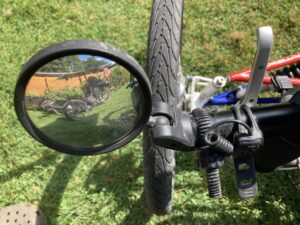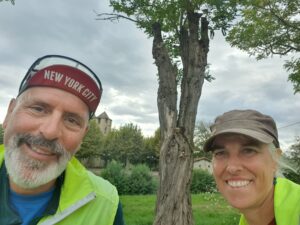 Contributor: Jeff Balch
Contributor: Jeff Balch
Twenty minutes of comfortable pedaling on Monday, Aug. 27, brought me four miles from south Evanston to Wilmette, where I met Megan Routbort and Thomas Polo – a pair of adventurers who, at that point, had pedaled roughly 750 times farther than I did that day.
They were easy to spot near the Metra station: two young people tucked into weathered recumbent tricycles, which from a distance might have been mistaken for golf carts. But the dark, flat, rectangular parasols over their heads were, in fact, 200-watt solar panels that had helped propel them from Berkeley, California, over the preceding 44 days.
The day before, I had received an email from Megan, messaging from Milwaukee to ask if we would accept them as houseguests for one night. I accepted their request and decided to pedal to Wilmette to meet them and guide them in.
Experienced navigators Megan and Thomas needed no shepherding, but from Wilmette, I led them to the lakefront, then to a restaurant where my wife Dori joined us, and then back to our house. We spent the evening absorbing their remarkable story. Committed to low-emissions travel, they crewed sailing vessels from the Mediterranean to the Americas from late 2023 to early 2024, beginning a “climate-positive world tour.”
Philosophy
Three principles underlie the travel choices of the two cyclists – co-founders of The Green Journey – Reduce, Respect, Restore:
Reduce environmental impact through “low-carbon transportation” and rideshare –avoiding air travel and individual non-human-powered transportation – while eating locally and low on the food chain.
Respect communities and local economies, remaining open-minded in storytelling and recognizing the limits of responsible travel – perhaps skipping a destination to help preserve it.
Restore ecosystems by advocating for a better climate future and dedicating some travel time to conservation projects along the way.
“Do you envision emissions-free travel becoming the norm?” I asked.
“It has to, someday,” Megan answered. A generation younger than I, she and Thomas briefly discussed whether the world would move significantly in this direction in their lifetimes. As I listened, I recalled my own transcontinental ride, which followed a self-indulgent flight with my boxed-up Raleigh bike from Boston to the Bay Area (and no sailboats).
 Practicalities
Practicalities
Megan’s and Thomas’s self-built trikes, each weighing about 100 pounds when loaded with their gear, are a challenge to propel without the solar-power assist – particularly uphill. With legs alone, it can take a half-hour to roll a mile. But the 200-watt solar panel feeds energy to a 1.2 kilowatt-hour battery, which in turn feeds a 500-watt motor to help maintain an average speed of 12-15 miles per hour.
Over time, the cyclists have observed that with a full kilowatt of charge, using battery only, they can travel about 100 miles. I noted this is roughly 20 times the performance of our Chevy Bolt, which at best gets 5 miles per kilowatt-hour. This stands to reason: the Bolt is roughly 20 times heavier than a Green Journey trike with a rider.
In daylight, one of the cyclists’ batteries can simultaneously receive power from the panel and send power to the motor. Thus, in full sunshine, its charge can be restored even as it provides pedal-assist. Early or late in the day, without full sun, the battery will gradually drain. If necessary, it can be recharged overnight from a wall outlet.
On cloudy days, according to Megan, the pedal-assist provides roughly one-quarter of the energy used, with the cyclists covering less ground. That fraction can rise to three-quarters on sunny days; on one such day in the Dakotas they covered 120 miles. She does not deny using the pedal-assist throttle a bit more on hills.
 Traveling west-to-east in the northern hemisphere, the cyclists see the sun to their right (in the southern sky) for much of the day. This raises the interesting question of whether an articulated panel – a panel that can be tilted to face the sun more directly – can improve performance.
Traveling west-to-east in the northern hemisphere, the cyclists see the sun to their right (in the southern sky) for much of the day. This raises the interesting question of whether an articulated panel – a panel that can be tilted to face the sun more directly – can improve performance.
The answer is yes, by a factor of around 30%. Such articulation would involve a structural challenge currently beyond Megan’s and Thomas’s engineering means, but not by much. Perhaps Green Journey 2.0 will incorporate such a tweak.
Their average pace does not require anything close to maximum throttle. Typically, they use less than 200 watts for the e-assist. Thomas, whose motor is gauged at 800 watts rather than 500, did try maxing out once – and briefly attained a speed of 37 mph. “It was not a pleasant experience for him,” Megan reported.
Road stories
As any coast-to-coast traveler knows, long Western stretches are vast and unsettled. Toward the end of the first week, Megan and Thomas left California and continued east on Nevada’s Route 50, famously dubbed “America’s loneliest road.” The 24-foot-wide ribbon of pavement crosses a high desert zone several hundred miles wide. As it spans the largely desolate state, Route 50 covers roughly one long, skinny square mile out of tens of thousands of square miles of sagebrush.
This is the Great Basin region, from which the sparse rain does not flow. The cyclists visited one or two tiny towns per day. As Megan notes in her journal: “For a bikepacker, the deserted road holds promise and peril. You have to balance the allure of car-free riding with the obligation to stuff your panniers full of spare tires, ramen, Gatorade. Dan and Natasha [two WarmShowers hosts in Lake Tahoe] warned me and Polo that we couldn’t expect to see other cyclists…”
But the infrequent human interactions in this region were consistently positive. The pair noted that varying political views did not impede discussions. Climate change doubters as well as nonskeptics were open to the appeal of self-propelled, solar-assisted transportation. And the long empty road out of Nevada ultimately led to Delta, Utah, where WarmShowers hosts Becky and Richard Dziuk demonstrated that they are, again to quote Megan, “something of an institution, the only cycle-friendly home in a 300-mile radius.”
 Two thousand miles east, a night after their Evanston stopover, the Green Journey cyclists told these stories and others in Chicago at Kozy’s Cyclery to a rapt audience of fellow bikepackers and solar aficionados. As in Nevada, Utah and pretty much everywhere else, the listeners in Chicago were attentive, curious and supportive.
Two thousand miles east, a night after their Evanston stopover, the Green Journey cyclists told these stories and others in Chicago at Kozy’s Cyclery to a rapt audience of fellow bikepackers and solar aficionados. As in Nevada, Utah and pretty much everywhere else, the listeners in Chicago were attentive, curious and supportive.
At the Kozy’s event, Megan and Thomas explained that besides the standard gear toted by any touring cyclist, they carry a few “bells and whistles,” such as extra cameras and notebooks for trip documentation – all of which is viewable at The Green Journey. At that site, one can also read Megan’s reflections and trace the pair’s 20-state, 4,500-mile route – Illinois being state 10.
As they rolled out of our backyard prior to heading downtown and further east, I noted an odometer reading of 2,998. They hit 3,000 a few minutes later over at the lakefront. From Chicago, via 10 more states and the District of Columbia, they will cover another 1,500 miles to their end-point in New York City.
By then, they will have burned many more calories than the typical cross-country traveler, but virtually the only carbon dioxide they will have added to the atmosphere will be what they exhaled.






